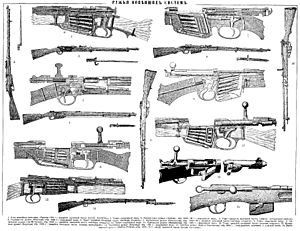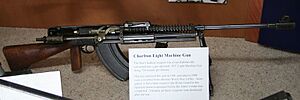Lee–Metford facts for kids
Quick facts for kids Magazine Lee–Metford Rifle |
|
|---|---|
 |
|
| Type | Service rifle |
| Place of origin | United Kingdom |
| Service history | |
| In service | 1888–present (ceremonial) |
| Used by | See Users |
| Wars | various Colonial conflicts First Sino-Japanese War First Italo-Ethiopian War Second Boer War Boxer Rebellion British expedition to Tibet 1904 Paraguayan Revolution World War I (limited) Irish War of Independence Chaco War Second Italo-Ethiopian War World War II |
| Production history | |
| Designer | James Paris Lee, RSAF Enfield |
| Manufacturer | RSAF Enfield |
| Unit cost | £3/15/– = £3.75 in 1892-1893 |
| Produced | 1884–1896 |
| Variants | MLM Mk II MLM Carbine Charlton Automatic Rifle |
| Specifications | |
| Length | 49.5 in (1,257 mm) |
| Barrel length | 30.2 in (767mm) |
|
|
|
| Cartridge | Cartridge .303 Mk I |
| Calibre | .303 inch (7.7 mm) |
| Action | Bolt-action |
| Rate of fire | 20 rounds/minute |
| Muzzle velocity | 2,040 ft/s (621.8 m/s) |
| Effective firing range | c. 800 yards (730 m) |
| Maximum firing range | 1,800 yards (1,600 m) |
| Feed system | 8 or 10-round magazine |
| Sights | Sliding leaf rear sights, Fixed-post front sights, "Dial" long-range volley sights |
The Lee–Metford rifle was an important bolt-action rifle used by the British army. It combined a special bolt system and a removable magazine designed by James Paris Lee. It also featured a unique barrel with seven grooves, created by William Ellis Metford.
This rifle took the place of the Martini–Henry rifle in 1888. It was developed over nine years of testing. However, it was only used for a short time before being replaced by the very similar Lee–Enfield rifle.
Contents
How the Lee-Metford Rifle Was Designed
The Lee–Metford rifle had some clever features that made it special for its time.
Lee's Bolt System
James Paris Lee's bolt action was much better than other designs.
- The handle for the bolt was placed closer to the shooter, right above the trigger. This made it much faster to use.
- Shooters could also hold the bolt with their thumb and index finger while still using their middle finger for the trigger.
- The bolt did not have to travel very far. This meant the shooter did not have to lift their head to pull the bolt back.
- The bolt only needed to turn 60 degrees to open. Other rifles often needed a 90-degree turn. This made it quicker and helped the shooter keep their aim.
Metford's Barrel and Magazine
Lee also added a great new feature: a detachable box magazine. Most other repeating rifles at the time had magazines built into the rifle. Lee's magazine could hold more bullets than other designs.
Metford's special barrel had what is called polygonal rifling. This design helped stop gunpowder residue from building up inside the barrel. It also made the rifle much easier to clean.
The Black Powder Problem
Even with its good features, the Lee–Metford had a big problem. It used cartridges filled with black powder. By the time this rifle came out, newer rifles were using smokeless powder. Smokeless powder allowed bullets to fly much faster without as much smoke or residue.
The .303 ammunition for the rifle was meant to use smokeless powder. But there were delays in making smokeless powder ready. So, the British army had to use black powder for a while.
When a smokeless powder called Cordite became available, it caused another issue. The shallow grooves in the Metford barrel wore out quickly with Cordite. The barrel would become unusable after about 6,000 shots. In comparison, rifles with deeper, square-cut "Enfield" rifling could fire 10,000 rounds. Because of this, Lee rifles fitted with Enfield barrels became known as Lee–Enfields.
Changes Over Time
Despite the issues with black powder, the Lee–Metford was updated several times. The main changes were to the magazine, which went from holding eight rounds to ten. The sights and safety features were also improved.
Starting in 1895, the Lee–Metford began to be replaced by the Lee–Enfield. This change was mainly because of the barrel issue and the need for new sights that worked better with smokeless powder.
Why the Lee-Metford Was Replaced
It took several years to replace all the Lee–Metford rifles. Some units were still using them during the Second Boer War in 1899.
The British army thought about making a completely new rifle, called the Pattern 1913 Enfield. This new rifle was based on a different design. However, its development stopped when World War I began. The Lee–Enfield, which was very adaptable, continued to be used for another fifty years.
Many Lee–Metford rifles were later updated to be like the newer Lee–Enfield models. This usually involved changing the barrel to the Enfield type. The Lee–Metford was also sold to civilians for target shooting before World War I. Many shooters thought it was more accurate than the Enfield rifling.
The Lee–Metford rifle remained a backup weapon in many parts of the British Empire even into World War II. For example, it was given to the New Zealand Home Guard and the Australian Volunteer Defence Corps until more modern rifles could be found. Today, the Lee–Metford is still used for special ceremonies by the Atholl Highlanders.
The Charlton Automatic Rifle
Some Lee–Metford rifles were changed into experimental automatic rifles. One of the most famous was the Charlton Automatic Rifle. It was designed by Philip Charlton in New Zealand in 1941. This rifle was meant to be a replacement for light machine guns like the Bren and Lewis gun, which were in short supply during World War II.
When Japan joined the war in 1941, New Zealand needed more light machine guns for local defense. So, the New Zealand Government paid for the development of self-loading versions of the Lee–Metford rifle. The Charlton Automatic Rifle was the result. It was given to Home Guard units in New Zealand starting in 1942. Over 1,500 of these rifles were made. A few were also made in Australia.
Most of the Charlton Automatic Rifles were destroyed in a fire after World War II. However, a few examples can still be seen in museums and private collections today.
Users
 Ethiopia
Ethiopia Paraguay: About 3,000 rifles were brought into the country by rebels in 1904. They were also used during the Chaco War.
Paraguay: About 3,000 rifles were brought into the country by rebels in 1904. They were also used during the Chaco War. China
China Tibet: Copies were made in local workshops in the early 1900s. In 1914, 5,000 extra British rifles were bought.
Tibet: Copies were made in local workshops in the early 1900s. In 1914, 5,000 extra British rifles were bought. United Kingdom: Still used by the Atholl Highlanders for special ceremonies.
United Kingdom: Still used by the Atholl Highlanders for special ceremonies.
See also
- British military rifles
- M1895 Lee Navy
- M1885 Remington-Lee



